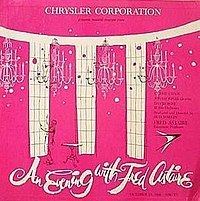8.6 /10 1 Votes8.6
Original language(s) English Final episode date 17 October 1958 | 8.7/10 IMDb Initial release 17 October 1958 First episode date 17 October 1958 | |||||||||||||||||||||||||||||||||
 | ||||||||||||||||||||||||||||||||||
Starring Fred AstaireBarrie Chase Similar A Family Upside Down, Départ de Jérusalem en chemi, Doorman, From the Earth to the Moon, A Damsel in Distress | ||||||||||||||||||||||||||||||||||
An Evening with Fred Astaire is a one-hour live television special starring Fred Astaire, broadcast on NBC on October 17, 1958. It was highly successful, winning nine Emmy awards and spawning three further specials, and technically innovative, as it was the first major television show to be recorded on color videotape. It was produced at NBC's Color City studios in Burbank, California.
Contents
Considered something of a comeback for the then 59-year-old Astaire, the special was his first starring role on television. It was directed and co-produced by Bud Yorkin and introduced Astaire's new partner Barrie Chase, whom he would later describe in Interview magazine in 1973 as perhaps his favorite dance partner. The Jonah Jones Quartet and David Rose and his Orchestra provided the music, and the Hermes Pan Dancers appeared in the ensemble dance numbers. The announcer was Art Gilmore, who at the time was the voice of the Chrysler Corporation, the show's sponsor. Typical for advertising of the era, Chrysler's 1959 model year Forward Look cars featured prominently in the show; Astaire's final words were "I only hope the show is as good as the cars."
The use of videotape
The program was highly innovative in its use of color videotape, a technology then in its infancy. Edward Stephenson designed the production, receiving Art Director credit. (note Production Design as a television art department credit did not become vogue until the late 1970s). Ed Stephenson was awarded an art direction Emmy for his work on the TV special.
As with the first major television program to be recorded on videotape-- The Edsel Show in 1957, this was a straight recording of a live performance with no editing. Early videotape use was confined largely to rebroadcasting programs from the east coast three hours later in the west, and was a cheaper, better-quality alternative to the film-based kinescopes. The experimental low-band quadruplex recording system in use was troublesome and hard to copy. Furthermore, early video editing was a highly complicated matter that required the engineer to cover the two-inch tape with iron oxide solution to locate the magnetic tracks and then splice it with a razor blade.
Although it was recorded live, An Evening with Fred Astaire used a number of innovative production techniques that are now commonplace, such as chroma key, and dissolves between scenes.
In 1988, the show earned a further technical Emmy Award for Ed Reitan, Don Kent, and Dan Einstein, who restored the original videotape, transferring its contents to a modern format. (The three had also restored the oldest color videotape known to exist, the dedication of WRC-TV's new studio in Washington, DC on May 21, 1958.)
The show was rebroadcast twice, on NBC on January 26, 1959, and on CBS on December 20, 1964. It was thus one of the earliest shows to be rerun using color videotape. The 1964 rebroadcast used a different beginning and ending that eliminated the advertising for Chrysler; instead the opening and closing dances were shown uninterrupted.
Musical numbers
Sequels
Astaire produced another three similar specials, each featuring Barrie Chase:
Media coverage
Astaire's first foray into television dance, and the introduction of his new dance partner, Barrie Chase, drew significant media coverage, the most prominent being a feature on the cover of TV Guide for October 11–17, 1958 and an inside article: "Now for the Dance Bash", formally announcing the new partnership to the American public. The show went on to win the Trendex rating race for its time slot and the week. TV Guide followed up with an in-depth feature article on December 13, 1958: "How Fred Astaire discovered Barrie Chase" and again featured Astaire and Chase on its cover on October 31, 1959, promoting Another Evening with Fred Astaire.
Not all media coverage was so positive however. After the show won an unprecedented nine Emmy awards, Ed Sullivan queried whether Astaire should have been awarded the Best Actor Award. Astaire promptly offered to return the award protesting: "I'm an actor, and this Emmy is for a performance by an actor, isn't it? When I do a difficult pantomime in a dance which tells a story, what do they think it is? Tiddlywinks?". He kept the award, but when Variety reported that MCA had lost $75,000 on the show he retorted angrily: "Kindly retract erroneous article in last week's Variety. Here are the facts: The entire package is mine, via Ava Productions Corp. MCA merely acted as my agent with the sponsor. Nobody had any cut. All the expenses were paid for by me and the show definitely turned in a sizeable profit. Though I was not interested in that phase, I would like to make it clear that I am not completely nuts. I particularly directed that no expense be spared in carrying out my plans, ideas and designs for the show which I had been working on for some time."
